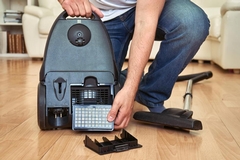
When it comes to mold remediation, maintaining air quality is of utmost importance, as airborne mold spores can spread rapidly and worsen existing health concerns. To combat this issue effectively, using advanced air filtration systems has become indispensable.
At RestoreMore, we understand the complex relationship between mold remediation and air quality restoration. With a commitment to providing specialized service offerings, we use state-of-the-art technology and filtration methods to ensure safe and healthy environments for our clients.
Why Air Filtration Systems Matter
When a mold remediation team addresses an infestation, it is not enough to simply remove the visible mold. An often overlooked aspect of the remediation process is restoring the air quality that has been compromised. Poor air quality can continue to perpetuate health issues even after the visible mold has been eliminated. This is where air filtration systems come into play. Air filtration systems work to actively remove airborne spores and mycotoxins, improving indoor air quality and ensuring that the environment is safe.
Cutting-Edge Air Filtration Technologies
Several innovative technologies exist today that enhance the efficacy of mold remediation through improved air quality management. Let's explore some of these advanced air filtration systems:
- HEPA Filters
High-efficiency particulate air (HEPA) filters are widely regarded as one of the most effective filtration solutions available. These filters can remove up to 99.97% of particles as small as 0.3 microns, including mold spores, dust, and pollen.
Effectiveness: HEPA filters trap smaller particles that other filtration methods might miss.
Usage: These filters are used in air purifiers and HVAC systems to continuously purify the air, making them a staple in any mold remediation project.
- Activated Carbon Filters
While HEPA filters are excellent for removing particulate matter, activated carbon filters serve a different purpose: they eliminate odors and volatile organic compounds (VOCs) from indoor air.
Mechanism: Activated carbon uses adsorption to capture gases and odors, improving air quality.
Combination with HEPA: Often, these filters are combined with HEPA filters in air purifiers to offer a dual-layer approach to air purification.
- UV-C Light Technology
Ultraviolet (UV) light systems have become an innovative solution for killing mold spores and pathogens present in indoor air.
Mechanism: UV-C light disrupts the DNA of mold spores, rendering them unable to reproduce.
Integration: These systems are typically installed in HVAC ducts, allowing them to provide continuous air treatment.
- Negative Ion Generators
Negative ion generators release negatively charged ions into the air, causing particles like mold spores to clump together and become heavy enough to fall to surfaces rather than remain airborne. They not only help improve air quality but can also neutralize odors.
The Role of Air Filtration in the Mold Remediation Process
Integrating air filtration technology into mold remediation involves several essential steps:
- Full Assessment: Before any remediation begins, a thorough assessment is needed. This includes evaluating moisture sources, affected areas, and existing air quality metrics.
- Containment: Once the assessment is complete, the next step is to contain the affected areas to prevent mold spores from spreading.
- Remediation and Removal: During the remediation phase, visible mold is physically removed. This often involves removing materials like drywall, insulation, and carpet, in conjunction with the use of personal protective equipment (PPE) to protect the health of remediation specialists.
- Air Filtration and Purification: After mold removal, advanced air filtration systems come into action. High-capacity HEPA filters and activated carbon systems are used to purge the air of remaining spores and contaminants.
- Final Air Quality Testing: Once remediation is complete, air quality testing should be performed to ensure that the environment is safe for occupancy. This often includes testing for remaining mold spores, VOCs, and other pollutants.
Conclusion: Investing in Air Quality Restoration
In the fight against mold, the integration of cutting-edge air filtration systems must not be overlooked. At RestoreMore, we recognize the vital role that these technologies play in protecting our clients' health and properties. In a world where environmental health is more important than ever, ensuring that your indoor air quality is pristine can pave the way for a healthier life.
If you are facing mold issues in your home or workplace, take proactive measures today. Trust the professionals at RestoreMore to restore your indoor air quality and peace of mind through our comprehensive mold remediation services.